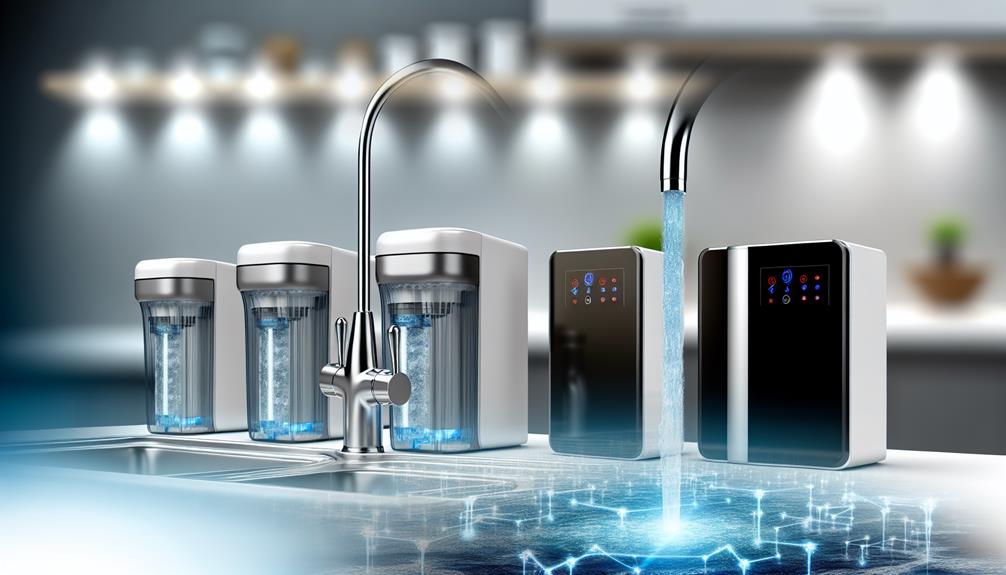As a gardener carefully selects filters to protect the integrity of a cherished koi pond, you too must consider the nuanced approaches required to adapt water filtration systems to the growing challenges posed by climate change.
As you're keenly aware, water quality and availability are shifting under the weight of altered weather patterns and environmental stressors, demanding innovative strategies for ensuring safe drinking water.
Whether you're managing municipal supplies or safeguarding individual homes, the resilience of your water filters has never been more critical.
You'll find that the journey toward effective adaptation is as much about technology as it is about policy and community engagement.
With the stakes rising like the tides, it's imperative to explore, together, how we can fortify our defenses against the unpredictable onslaught of a changing climate, leaving you to ponder the next steps in this vital quest for water security.
Climate-Driven Water Scarcity
As climate change intensifies, the impacts on water resources become more evident. Droughts, erratic rainfall, and extreme temperatures are expected to worsen water scarcity, posing challenges to current water filtration systems. The need for robust adaptation strategies in water resource management becomes crucial in a world where the effects of climate change are tangible realities.
Global warming drives extreme weather events like floods and droughts, further emphasizing the importance of adaptation. Rising sea levels and changing precipitation patterns contribute to higher concentrations of contaminants in water bodies, putting pressure on filtration systems. This leads to reduced natural dilution and increases the risk of toxic conditions that threaten various species and water safety for recreational use.
To address these challenges, an analytical approach to water scarcity is essential. Integration of policy and management frameworks that can dynamically respond to a changing climate is crucial. Flexibility in water treatment processes, active participation from stakeholders, and comprehensive risk management are vital to ensure a safe and sustainable water supply. Combating water scarcity requires both technological innovation and resilience in planning.
Temperature Fluctuations' Impact
Building on the challenges of water scarcity, it's important to consider how temperature fluctuations further complicate water filtration efforts.
Climate change on water systems manifests significantly through rising temperatures, which in turn affect water quality and filtration processes. Higher temperatures lead to thermal stratification in bodies of water, which can result in oxygen depletion and promote algal blooms that release toxins, complicating water treatment.
Warmer water not only impacts water ecosystems but also encourages the growth of harmful bacteria and parasites. This means that existing water filtration systems must adapt to counter the increased biological hazards. Temperature changes affect the rate of chemical reactions, and with higher water temperatures, there's an accelerated formation of potentially harmful byproducts during water treatment.
As a response to these changing climatic conditions, water filters must be designed to handle the variable impacts on water quality caused by temperature fluctuations' impact. This could include enhancing the filtration media to tackle the increased biological load and incorporating methods to mitigate the formation of toxic byproducts at higher temperatures.
Your approach to water filtration should be dynamic, anticipating the challenges posed by a warming climate and ensuring water safety and availability despite these adversities.
Increased Pollutant Concentrations
Climate change exacerbates the concentration of pollutants in our water sources, necessitating advanced filtration solutions to ensure safe consumption.
As you're aware, climate change impacts include more frequent and intense droughts and heavy rainfall. Both extremes lead to the contamination of water, with drought reducing dilution and heavy rainfall overwhelming stormwater management systems. This results in elevated levels of contaminants like bacteria, parasites, and chemicals.
Rising temperatures contribute to thermal stratification in water bodies, leading to oxygen depletion and further increasing water pollution. These conditions also accelerate chemical reactions, potentially releasing more toxins into the water. As a result, water quality suffers, and existing water treatment processes face significant challenges.
To adapt, risk management strategies must evolve. Innovative filtration technologies that can cope with higher contaminant loads are critical. Additionally, enhancing stormwater management infrastructure can mitigate the impacts of sudden, increasing water flow and its pollutant load.
Waterborne Disease Risks
Understanding the escalating pollutant concentrations is crucial, yet we must equally prioritize the burgeoning risks of waterborne diseases as temperatures rise and extreme weather events become more commonplace. Climate change scenarios predict alterations in rainfall patterns, leading to both droughts and floods, which can compromise drinking water quality by introducing a variety of contaminants into water sources. As a result, water treatment facilities face the challenge of adapting their disinfection methods to ensure public health isn't compromised by waterborne disease risks.
Increased bacterial growth, a consequence of higher temperatures, necessitates more robust water treatment protocols. Saline intrusion, particularly in coastal areas, further complicates the purification process, introducing new contaminants in water that can be harmful to vulnerable populations. To tackle these issues, it's essential to enhance the resilience of water infrastructure and implement early warning systems for water contamination.
As you consider the safety of your drinking water, be aware that the adequacy of existing disinfection methods must be continually assessed in light of these new risks. Proactive measures, including the upgrade of water treatment facilities and the development of more advanced filtration technologies, are vital steps in safeguarding against the increased waterborne disease risks posed by climate change.
Infrastructure Resilience Strategies
To effectively adapt to the impacts of climate change on water quality, infrastructure resilience strategies must incorporate comprehensive policy frameworks and engage multiple stakeholders in unified efforts.
You'll need to prioritize adaptation through green infrastructure solutions, such as retention ponds and permeable pavements, which address both stormwater management and water treatment challenges. These systems can mitigate the effects of sea level rise and enhance rainwater harvesting, contributing to a sustainable water supply.
Developing a robust data wish-list, assembling existing datasets, and routinely re-evaluating land use maps are crucial for managing water resources effectively. As you seek partnerships, remember that collaboration across all levels of government and with tribal agencies is vital for crafting regional policies and maintenance schedules that support green infrastructure.
Moreover, you mustn't overlook the importance of public engagement. Showcasing successful green infrastructure projects raises awareness and drives home the importance of addressing increasing water demand in the face of climate change.

